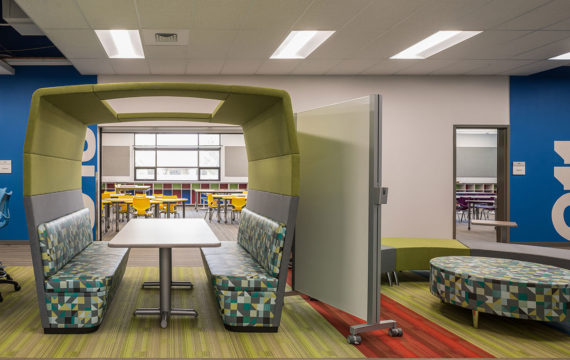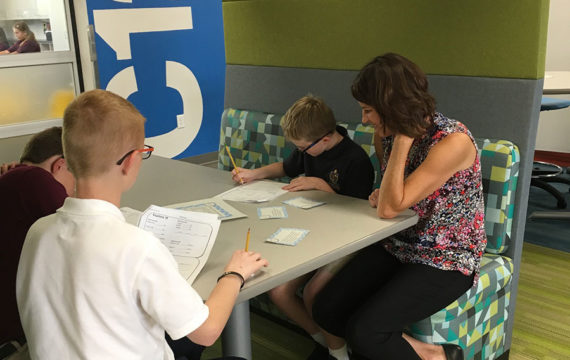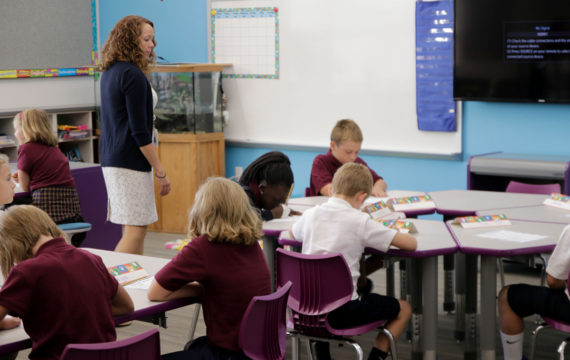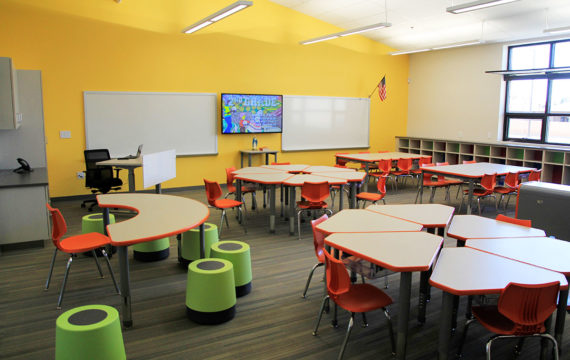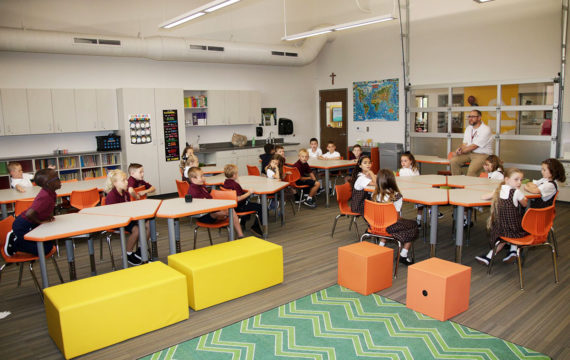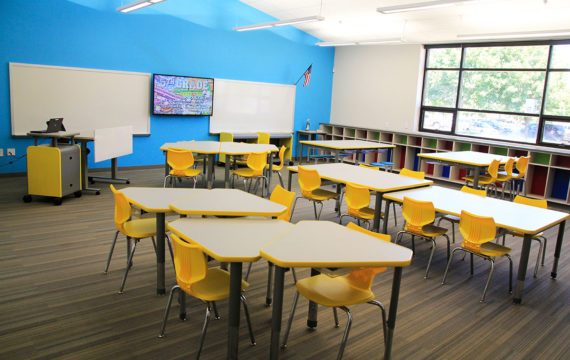Academic Design
In the Ignatian tradition, we treasure the individuality of each child, and we are committed to addressing the academic challenges and strengths of each student. Given our commitment to Cura Personalis and high individualization for every student, we have established an academic design and strategies that establishes a personalized education for each of our students. The core pillars of St. Ignatius’ academic model are five inter-related, innovative approaches that complement one-another and combine to create an individualized, rigorous learning environment where every student is supported to grow and succeed across academic subjects. We have spent time researching, visiting other schools, and learning about these instructional methods, and we are confident that they will support our goal for each student to reach his/her highest potential.
THE FIVE PILLARS ARE:
#1: STATION ROTATION & BLENDED LEARNING in math and English & language arts;
St. Ignatius uses station rotation and blended learning as the foundation of lesson planning in math and English and language arts (ELA). Station rotation is a classroom design model in which students in small, ability-differentiated groups rotate through various classroom activities, including a technology-enabled blended learning activity. This type of instruction allows us to:
- Tailor instruction to students’ individual needs, supported by teachers in a small-group setting;
- Respect differences in students’ learning styles by providing opportunities to learn a skill or subject via different modalities and activities;
- Create structures to enable effective ability grouping across age levels and between classrooms; and,
- Foster a more engaging classroom environment by dividing an instructional block into multiple, dynamic activity blocks.
Our rotation model includes 3-4 activity stations, 1 teacher-led, 1 technology-enabled, and 1-2 collaborative stations, in 60-90 minute blocks. Students will be grouped according to their skill mastery in the subject, and groups will change dynamically throughout the year.
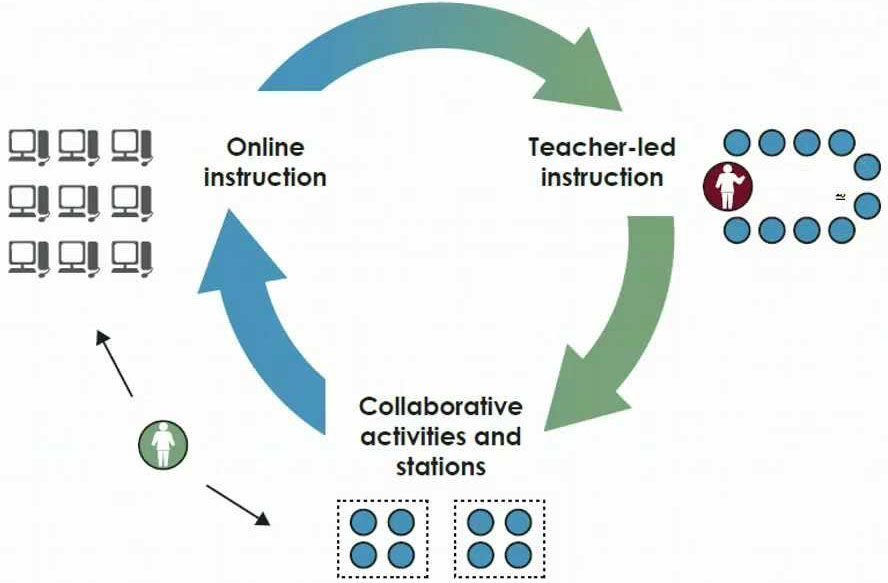 At the middle school level, St. Ignatius incorporates more independent work opportunities for students and flexibility for teachers to experiment with what models work best for achieving student growth goals. Elements of student choice and agency are integrated into station rotation, for example, by offering multiple choices of collaborative activities.
At the middle school level, St. Ignatius incorporates more independent work opportunities for students and flexibility for teachers to experiment with what models work best for achieving student growth goals. Elements of student choice and agency are integrated into station rotation, for example, by offering multiple choices of collaborative activities.
Blended learning is facilitated by adaptive learning software. A 2015 study by the Rand Corporation and the Gates Foundation found that technology-enabled personalized learning approaches have a significant positive impact on student academic achievement, especially in elementary school math.
At the end of an instructional block of station rotation, teachers have a wealth of information to inform their assessment of each student’s work and progress, and shape plans for groups and activities in the next lesson. First, they have their own observations from working closely with every individual student in small groups. Second, they are able to review the work products from the collaborative activities. Finally, teachers have detailed data and progress reports from the blended learning software.
This innovative model is critical to creating an individualized, rigorous academic experience for our students and pushing them to reach their highest learning potential.
#2: SKILLS BASED GROUPING ACROSS GRADE LEVELS;
At St. Ignatius, we want to meet each student “where they are”. We don’t want student learning to be limited by grade level or age. We believe that each individual student’s mastery of a subject matter should dictate what and how they are learning any given subject matter.
Accordingly, St. Ignatius students from multiple grades are often combined into learning groups based on their mastery level in a certain subject area (rather than grade level). Students will be mixed across ages, according to their skill level. This structure enables students who are behind to get extra support, and students who are ahead of grade level to reach even further ahead and learn from similar ability peers.
The leadership team of St. Ignatius has many goals for piloting this approach, including to:
- Enable more differentiated instruction through ability groups, increasing teachers’ focus on each individual student’s learning progression instead of grade-level labels;
- Foster a “family” style learning environment in which older students set an example for younger students, who naturally look up to and emulate them;
- Encourage collaborative lesson planning and use of space among teachers.
#3: INQUIRY-BASED LEARNING infused across the curriculum and teaching methodology;
Inquiry-based learning is an instructional philosophy that employs certain teaching methods, lesson planning, and curricular techniques that will bring student curiosity and agency to the forefront of learning. In an inquiry-based classroom, teachers’ primary activity is facilitating learning, rather than delivering content or prescriptively delineating skills. Elements of inquiry-based learning and this teaching methodology are infused in all subjects at St. Ignatius.
In an inquiry-based project, students follow a four step cycle:
- Explore questions and topics,
- Investigate questions and experiment with answers,
- Exhibit what they have found or created, and
- Reflect on their learning to guide their next projects.
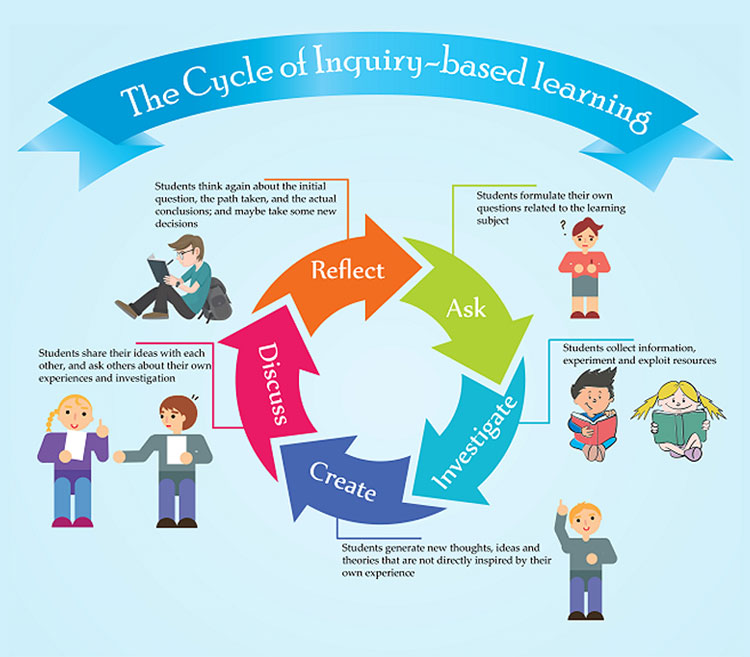
In addition to being a proven instructional philosophy, inquiry based learning is consistent with our Ignatian spirituality and the Ignatian Pedagogical Paradigm. Ignatian pedagogy derives from the underlying principles, values, and actions realized in the Spiritual Exercises of St. Ignatius of Loyola, founder of the Jesuits. During the Exercises, a retreatant (who is, in essence, a learner) is guided through a process of reading, reflection, and prayer by a spiritual director (who is, in essence, a teacher). The framework of Ignatian pedagogy, then, takes the general principles and approach of the Ignatian Spiritual Exercises and translates them into a process for educational practices more generally. (https://www.slu.edu/cttl/resources/ignatian-pedagogical-paradigm.php)
The five elements of Ignatian pedagogy- context, experience, reflection, action, and evaluation – derive from the underlying principles, values, and actions in St. Ignatius’s Spiritual Exercises. They can inform a course implicitly (e.g., in the instructor’s orientation toward his students) or be used explicitly to frame the course (e.g., in the course syllabus).
Ultimately, the elements of Ignatian pedagogy offer a way of understanding how deep, transformative learning occurs. The figure below offers a snapshot of how the process works:
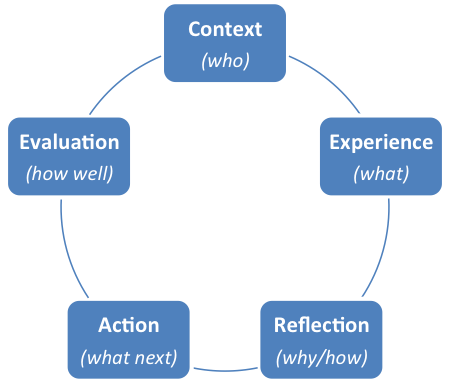
St. Ignatius Catholic School’s goals in adopting an inquiry-based teaching methodology and incorporation of the Ignatian Pedagogical Paradigm in our teaching instruction are to:
- Engage students in their learning process, and center each individual student in his or her own learning;
- Develop cross-disciplinary critical thinking skills, which students will be able to apply independently and in groups;
- Focus less on memorization and more on depth of learning; and
- Provide extensive opportunities for collaboration and teamwork among students.
#4: PERSONALIZED LEARNING PORTFOLIOS & STUDENT-LED CONFERENCES including academic and non-academic goals and progress metrics across grade levels;
To further support the whole student approach to St. Ignatius’ educational philosophy and the individualized approach to student instruction, each St. Ignatius student has an personalized learning portfolio, which is updated at least annually, and maintained over the long term as a record of growth. The PLP is reviewed and discussed at student-led conferences, where students, teachers, and parents evaluate student goals and progress in depth. The PLP is provided in addition to their mastery-based, academic report card.
Student-led conferences are conducted each spring (in addition to our fall parent-teacher conferences) to provide students with an opportunity to report to parents about their growth during the school year. These conferences are a critical opportunity for our students to engage in conversation with teachers and parents regarding their growth, goals, needs, and opportunities for improvement.
St Ignatius’ goals with Personalized Learning Portfolios and student led conferences are to:
- Support individualized learning by providing teachers, families, and students with a clear roadmap for students’ development goals and learning styles; and,
- Allow students to take accountability for their own learning, performance and behavior in school, and think deeply about their own goals, academic and otherwise; and,
- Elevate the importance of character values alongside academic content knowledge, while providing meaningful and targeted feedback in each realm; and,
- Improve student presentation and communication skills and effectively communicate progress to parents about students’ goals, strengths, and areas for improvement within and beyond academics.
Research on individualized learning plans suggest strong evidence of their non-academic benefits for student engagement in school, student self-knowledge of strengths and areas for development, increased teacher awareness of student individual performance to enable individualized learning, and improved family engagement and communication. There is also some evidence that Personalized Learning Portfolios can have a concrete impact on academic achievement levels.
Having multiple measures of success and multiple opportunities to acquire and demonstrate skills and knowledge is an important tenet of the grading philosophy at St. Ignatius. Challenges with behavior and responsibility are incorporated into the PLP and addressed appropriately, but they do not impact student academic grades. This way, grades in academic content areas accurately reflects student knowledge and skills, not classroom behavior or accountability. Those components are valued and discussed as separate, equally important areas for student growth.
Student-led conferencing is an increasingly popular alternative to traditional parent-teacher conferences. In a student-led conference, students present their goals, progress, strengths, and areas for improvement to their families and their teacher, and the group has a discussion. While these conferences only occur a few times per year, they reinforce the PLPs and bring them to life.
Research on student-led teacher conferences shows increased satisfaction with this model over more traditional models where teachers talk about students with parents. The student-led conference model presents a valuable opportunity to reinforce St. Ignatius’ core academic and non-academic values, and build strong relationships between teachers, students, and families.
Spring student-led conferences at St. Ignatius are tied to the structure and content of the student’s ILP. The specific model of the presentation vary somewhat by grade level, but even the youngest students are able to discuss their goals and progress with their parents. Each homeroom teacher facilitates the conference and helps students prepare. Other teachers are invited to attend as needed. Conferences are held face-to-face at least once per year, at the end of first trimester.
In the process of preparing for the conference, students are encouraged to think deeply about each aspect of their PLP and decide how to discuss their goals and progress with their families and teacher. Families have an opportunity to hear and understand more from their own child, with help and support from the teacher.
Outside of both our traditional parent-teacher and student-led conferences, families are encouraged to communicate with their child’s teacher formally and informally. Under no circumstances are conferences be the only opportunity for parents and teachers to discuss student learning goals.
#5: FLEXIBLE SEATING & LEARNING SPACES which easily enable cross-class collaboration in addition to students’ ability to care for their bodies at the same time as their minds.
The St. Ignatius facility was designed to enable flexibility within the school for students and teachers to be mobile rather than being constrained by four static walls. Each classroom has a “garage door” fourth wall that opens to a shared “pod” space. This space can be used by one class when more space is needed, or across classrooms when they are collaborating. This design flexibility is especially important for ability grouping, station rotation, and makerspace activities which may require more space for interaction, experimentation, and exploration. This facility enables easy movement of students among the classrooms, and enables use of the pod space for learning as well.
In addition to a building that fosters flexible learning environments, the furniture throughout the building enhances this goal for flexibility. Specifically, student seating fosters frequent movement and collaboration. All of the classrooms offer a mix of moveable desks, standing and sitting height tables, plush seating, and wobble stools. The middle school classrooms have furniture relevant to the subject area. For example, there is a presentation room designed for students to display their work proudly to peers and a math room with white board tops on all of the surfaces and many of the walls.
The building design also features two outdoor learning environments. Both the library and STEAM lab feature overhead doors that open to a secure outdoor area with tables and outdoor furniture. These rooms offer the ability to extend the learning environment seamlessly to the outdoors. The pleasant temperatures and plentiful sunshine in the fall and spring seasons in the Treasure Valley make these flexible environments ideal
These 5 pillars mutually support and complement one another, all contributing to a personalized learning environment in which every student across the spectrum of gifts, skills, abilities, and preferences is supported to reach his or her full potential, in the classroom and beyond.

